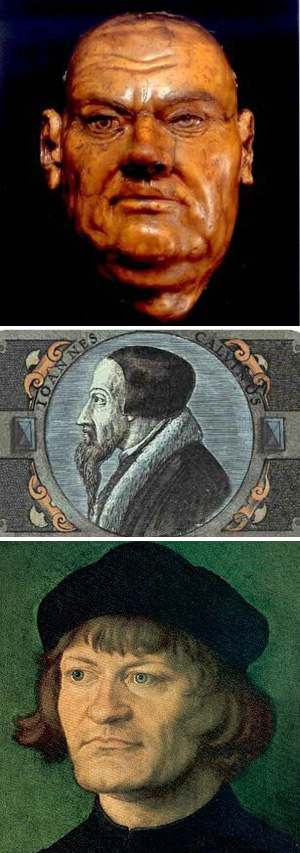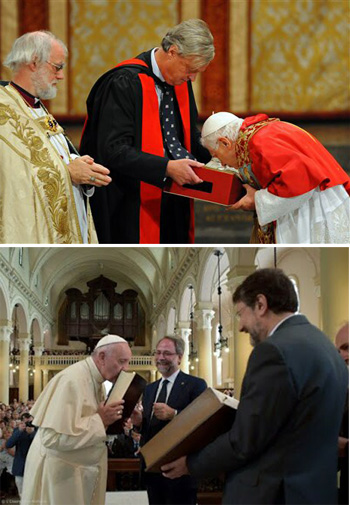WILL LUTHER BE THE NEXT CANONIZED ‘SAINT’?
Atila Sinke Guimarães
Novus Ordo is a nightmare and not Catholic...
When I read about the jubilant commemorations that the Conciliar Church
will sponsor together with the Lutheran World Federation at the end of
October in Sweden, I wondered whether Francis is preparing to surprise
the world by canonizing the revolted monk of the 16th century as another manifestations of his “mercy.” Indeed, after he has canonized immorality and Woodstock lifestyle with Wojtyla, has beatified homosexuality with Montini and enshrined religious indifferentism with Teresa of Calcutta, why could he not canonize heresy – blatant and furious heresy – with Luther?

Will Luther, Calvin & Zwingli be declared 'saints' by the Conciliar Church?
- 1970 – When the same Lutheran World Federation met at Evian, Card. Jan Willebrands, then president of the Secretariat for Promoting Christian Unity, spoke of Luther in terms that Catholics usually reserve for St. Thomas Aquinas. The latter justly deserves the title of “common master” or “common doctor,” meaning that he should be respected by all theological schools in the Church. Yet, Card. Willebrands praised Luther in his official speech, applying to Luther the title “common master.” (1)
- 1983 – As the 500th anniversary of the birth of the
heresiarch approached, John Paul II wrote a letter to Card. Willebrands
paying homage to Luther by calling him “doctor,” bringing to mind the
praise of Willebrands quoted above. These were Wojtyla’s words:
“November 10th is the 500th anniversary of the
birth of Doctor Martin Luther of Eisleben. On this occasion numerous
Christians remember that theologian who … contributed substantially to
the radical change of ecclesiastical and secular reality in the West.
Until today our world feels his great impact on History.”
Further in that letter, JPII responded to the Protestant request for dialogue and praises Luther: “I welcome this intention with satisfaction, seeing it as a fraternal invitation to achieve a more profound and complete vision of historical events and a critical analysis of Luther’s multifarious heritage through a common effort. Indeed, the scientific research of evangelical and Catholic scholars, which has already led to many points of convergence, have made a more complete and nuanced picture of Luther’s personality, as well as a more complex interlacing of the historical, political and ecclesiastical reality in the … 16th century. These results have given visible proof of the profound religiosity of Luther, who was moved by an ardent passion for the question of eternal salvation.” (2) - 1984 – In an ecumenical speech delivered at Bari, Card. Willebrands summarized what the Conciliar Church had done thus far to satisfy the demands of Martin Luther: “In addition to recovering the central role of Scripture in the Church and the live of the faithful, since Vatican II Catholics are increasingly willing to reassess the common priesthood of the faithful and the co-responsibility of laymen in the whole life of the Church; to recognize the character of the Pilgrim Church on earth; to reevaluate local churches; to accept liturgical reform with the introduction of national languages; to concede to having Communion under the two species and accept the declaration of religious liberty.” (3)
- As the year 2000 approached, John Paul II tried to establish a common martyrology for Catholics, Schismatics and Protestants. (4) With this aim, he made eulogies of Jan Hus, Zwingli and Calvin, giving the impression they would be included along with Luther in that list of saints. (5) The common martyrology did not fly. A strong reaction among traditionalists and muted internal resistance in the Roman Curia boycotted the initiative. This does not mean that Progressivism has changed its plan; on the contrary, its partisans are seeking an opportunity to make these heretics “saints.”
- 2011 – Benedict XVI emphatically pointed to Luther as a model to be followed (here). His support for Protestantism was constant during his entire pontificate. (here, here, here & here)
- Let us not forget that in 1999 Card. Raztinger, today Benedict XVI, was the one who penned the Catholic-Lutheran Augsburg Accord (here and here) on the doctrine of justification, which saved the ecumenical relationship with the Protestants from a complete shipwreck.

Above, Benedict XVI kisses the Anglican Gospel, London, September 2010; below, Francis kisses the Waldensian Bible, Rome, June 2015
Now, regarding the events planned for the end of October in Sweden, the news communiqué reports:
“The Lutheran World Federation – LWF – has released details of the two-day Joint Ecumenical Commemorations from October 31 to November 1 in Lund and Malmö in Sweden that will mark the official start of the 2017 Reformation Jubilee. The commemorations, which Pope Francis will attend, are jointly hosted by the LWF and the Catholic Church.” (6)
So, 51 years after the closing of Vatican II, the Conciliar Church has infiltrated the Catholic Church so forcefully that the teaching of the Council of Trent and the First Vatican Council, which uniformly reflect the perennial mind of the Church, were changed so radically that today Martin Luther, the heretic per antonomasia, is accepted as a great model to be followed. His act of revolt will be celebrated by a conciliar Pope in a public act before the whole world.
Does this not incline one to conjecture that Luther can be declared a “saint” of this apostate Church next month or sometime soon?
Who cannot see all these festivities as a clear proof that this Church hardly has anything Catholic in it?
- Cf. Jan Willebrands, “Lecture delivered at the 5th Assembly of the Lutheran World Federation, July 15, 1970, La Documentation Catholique, September, 6, 1970, pp. 765-766, apud Quo Vadis Petre?, Los Angeles: TIA, 1999, pp. 17-20.
- John Paul II, Letter to Cardinal Willlebrands of October 1983, published under the title “La verità storica su Lutero alimenti il dialogo per unità,” L’Osservatore Romano, November 6, 1983, apud ibid. pp. 21-22.
- J. Willebrands, Speech about Luther at the St. Nicolas Institute of Bari, published under the title “Il Card. Willebrands inaugura il corso dell’Instituto S. Nicola,” L’Osservatore Romano, February, 5, 1984, p. 6, apud ibid. pp. 20-21.
- Cf. Tertio millennio adveniente (1994, § 37); Ut unum sint (1995 § 48).
- Cf. Quo Vadis Petre? pp- 10-26
- The Tablet, September 3, 2016, p. 26.
